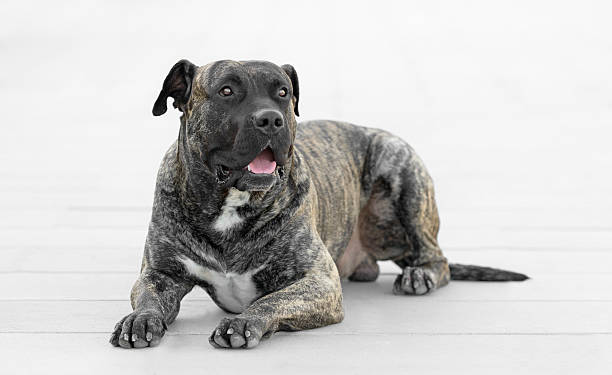Pressa Canario (Canary Mastiff)

Breed History:
The Presa Canario, also known as the Canary Mastiff or Perro de Presa Canario, is a powerful molosser-type breed developed in the Canary Islands, particularly Tenerife and Gran Canaria. The breed’s origins trace back to the 15th and 16th centuries when Spanish conquistadors brought mastiff-type dogs and crossed them with native island dogs. The resulting breed was used primarily for working livestock, guarding property, and subduing unruly cattle.
The Presa Canario was also historically used in dog fighting, a practice that nearly led to its extinction in the 20th century. A breed revival began in the 1970s through the efforts of fanciers dedicated to restoring its working qualities and native form. Officially recognised in Spain in the early 2000s, the breed is now prized for its strength, guarding instinct, and loyalty. It remains a symbol of the Canary Islands' cultural heritage.
Considering adopting a Pressa Canario or a similar giant breed? Check out our page "How to look after a Great Dane" detailing what to consider before adopting and our recommended products for a Great Dane and other giant dog breeds.
|
Gender |
Height |
Weight |
|
Male |
60-66 cm |
50-65 kg |
|
Female |
56-62 cm |
40-55 kg |
Size – Large
Life Expectancy: 9–11 years

Breed Appearance:
The Presa Canario is a large, muscular, and imposing dog with a broad chest, thick neck, and massive head. Its build reflects both power and agility. The skin is thick and loose, especially around the neck, giving it a wrinkled appearance. The muzzle is wide and strong, and the bite is typically a scissor or reverse scissor.
It has a short, coarse coat that lies flat against the body. Colours include fawn, brindle, and black, often with a dark facial mask. The ears may be cropped where legal, though natural ears are medium-sized and drop forward. The overall expression is serious, confident, and attentive, giving the Presa an unmistakable presence.
Breed Type – Guard/Working:
The Presa Canario is a natural guardian, bred for protection and livestock handling. It is deeply territorial and naturally wary of strangers, making it an effective guard dog for experienced owners. While aloof with outsiders, it is known to be affectionate, calm, and devoted within the family unit.
This breed has a dominant personality and requires clear leadership and a structured environment. It does not do well in chaotic or passive households. With proper training, socialisation, and firm handling, the Presa can be a stable, courageous companion and working dog. Its protective instincts make it especially suited to guarding homes, farms, and estates.

Training:
Training a Presa Canario requires a confident, experienced handler who understands large guardian breeds. It is brilliant and learns quickly, but has a strong will and dominant tendencies. Obedience training should begin early, focusing on impulse control, boundaries, and respectful behaviour.
Positive reinforcement paired with firm consistency works best. Harsh or erratic training methods can lead to fear or aggression. Socialisation is critical—this breed must be exposed to various people, animals, and environments from puppyhood to develop a balanced temperament. Without training and structure, it may become unmanageable or reactive.
Health & Care:
The Presa Canario is a generally healthy breed, but like most large breeds, can be prone to certain genetic issues. These include hip and elbow dysplasia, cardiac problems, entropion (inward-rolling eyelids), and gastric torsion (bloat). Responsible breeders screen for these conditions.
Its short coat requires minimal maintenance, but its large frame needs careful monitoring. A high-protein, joint-supportive diet and proper exercise are essential to maintain health. Avoid overfeeding to prevent obesity, which can strain joints and internal organs. Regular vet checkups and preventive care help ensure a long, active life.

Living Conditions:
The Presa Canario is best suited to homes with ample space, ideally with a secure yard. It is not appropriate for apartment living or inexperienced dog owners. This breed thrives in environments where it has clear rules, routine, and purpose.
Due to its strong guarding instinct, it may not be trustworthy off-leash or in unsecured areas. It may not tolerate unfamiliar dogs, especially those of the same sex, and early socialisation is necessary if it is to coexist peacefully with other animals. Presas are best placed with owners who lead an active, structured lifestyle and can provide strong guidance.
Exercise:
Though not overly hyper, the Presa Canario is a powerful, athletic breed that needs daily exercise to stay fit and mentally stable. One to two hours of physical activity—such as structured walks, play sessions, or obedience training—is ideal.
It does best with purposeful activity rather than aimless running. Interactive tasks like tracking, tug-of-war, or advanced obedience drills can help keep its mind engaged. Lack of exercise and stimulation can lead to destructive or aggressive behaviour.
Grooming:
Grooming the Presa Canario is simple due to its short, dense coat. Weekly brushing with a firm bristle brush helps remove dead hair and maintain coat health. More frequent brushing is recommended during seasonal shedding.
Bathing is required only occasionally unless the dog gets particularly dirty. Regular nail trimming, dental care, and ear cleaning are part of routine maintenance. Due to its size and strength, early habituation to grooming routines is highly recommended.

Advantages:
-
Powerful and effective guardian of property and livestock
-
Deeply loyal and protective of its family
-
Intelligent and capable of advanced training
-
Low grooming requirements and low odour
-
Confident, calm demeanour when well-trained
-
Strong deterrent presence due to size and appearance
Disadvantages:
-
Not suitable for novice or passive dog owners
-
Requires early and extensive socialisation
-
Can be aggressive toward unfamiliar dogs or people
-
Strong prey drive; caution needed with smaller pets
-
May be restricted or banned in certain regions due to breed-specific legislation
-
Needs firm, experienced handling and consistent leadership

